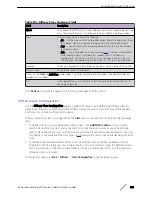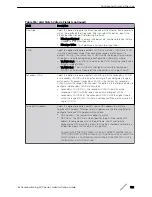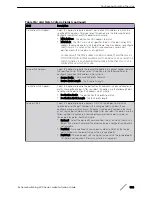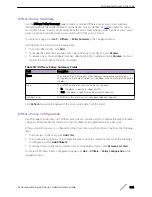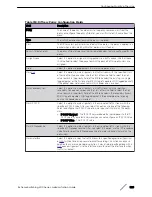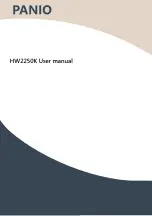
Table 304: Access Control List Control Plane Configuration Fields
Field
Description
ACL Identifier
The name or number that identifies the ACL.
ACL Type
The type of ACL. The ACL type determines the criteria that can be used to match
packets. The type also determines which attributes can be applied to matching
traffic. IPv4 ACLs classify Layer 3 and Layer 4 IPv4 traffic, IPv6 ACLs classify
Layer 3 and Layer 4 IPv6 traffic, and MAC ACLs classify Layer 2 traffic. The ACL
types are as follows:
•
IPv4 Standard – Match criteria is based on the source address of IPv4
packets.
•
IPv4 Extended – Match criteria can be based on the source and destination
addresses, source and destination Layer 4 ports, and protocol type of IPv4
packets.
•
IPv4 Named – Match criteria is the same as IPv4 Extended ACLs, but the ACL
ID can be an alphanumeric name instead of a number.
•
IPv6 Named – Match criteria can be based on information including the
source and destination IPv6 addresses, source and destination Layer 4 ports,
and protocol type within IPv6 packets.
•
Extended MAC – Match criteria can be based on the source and destination
MAC addresses, 802.1p user priority, VLAN ID, and EtherType value within
Ethernet frames.
Sequence Number
The order the ACL is applied to traffic on the interface relative to other ACLs
associated with the interface in the same direction. When multiple ACLs are
applied to the same interface in the same direction, the ACL with the lowest
sequence number is applied first, and the other ACLs are applied in ascending
numerical order.
IPv6 ACL Rules
The maximum number of IPv6 rules depends on the following factors (also refer to the 200 Series
Scaling Parameters and Values for the maximum number of rules per device type):
•
If both SRC IPv6 and DST IPv6 are part of the
rule, then the maximum number of rules is one
quarter the possible number for that device type.
•
If DSCP is part of the rule along with any other qualifier, then the maximum number of rules possible
are one quarter the possible number for that device type.
•
In all other cases, the maximum number of rules are equal to half the maximum possible for that
device type or 1021, whichever is smaller.
Scenarios
The following scenarios are provided as an example. Assume that your hardware processor can
accommodate a maximum of 1789 rules.
•
Scenario #1: If the rules have both SRC IPv6 and DST IPv6, then maximum rules possible are 1789/4
= 447.
•
Scenario #2: If the rules have DSCP along with any other qualifier, then the maximum number of
rules possible are 1789/4 = 447.
•
Scenario #3: In all the other cases, 894 rules can be accommodated.
Configuring Quality of Service
ExtremeSwitching 200 Series: Administration Guide
310
























